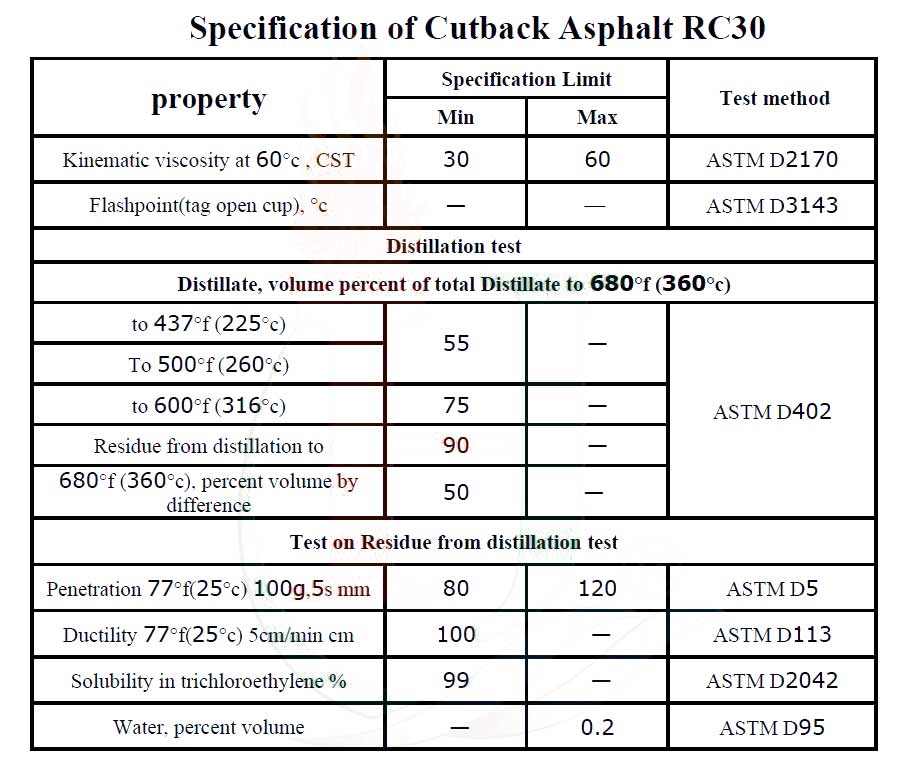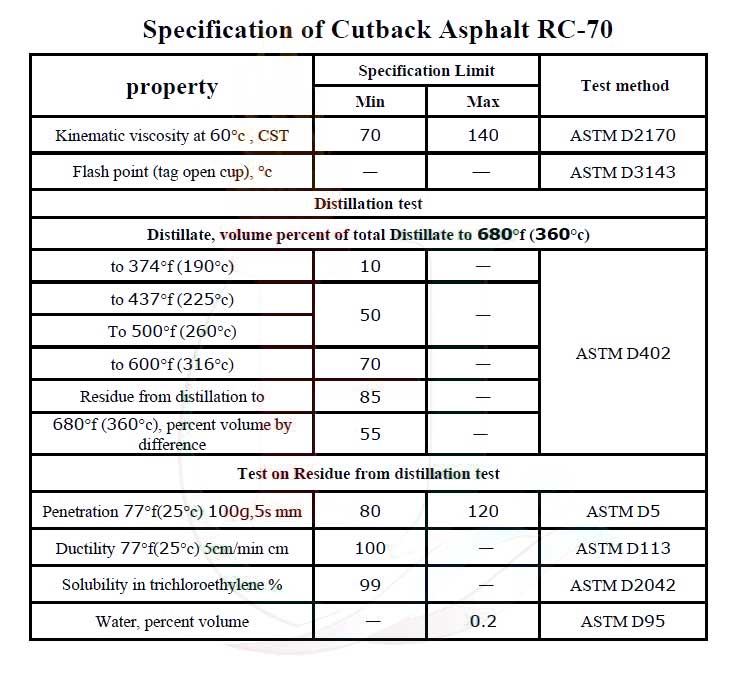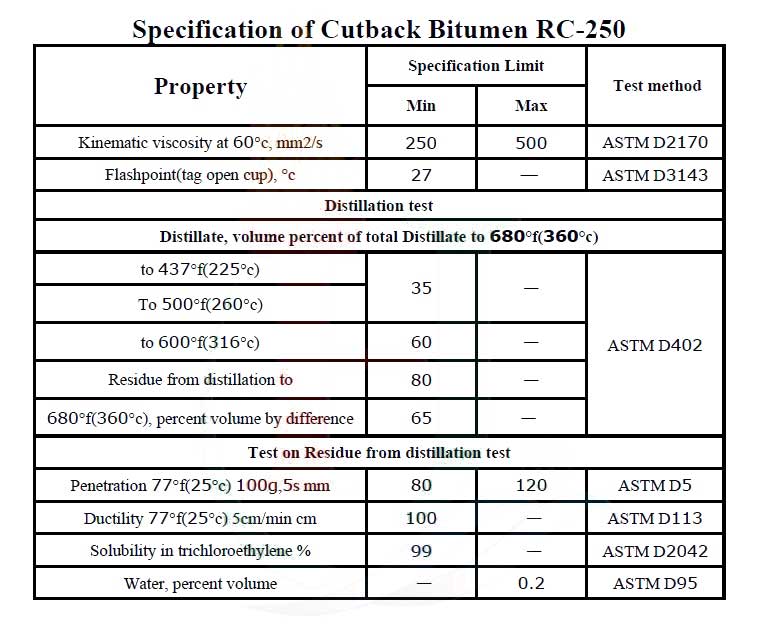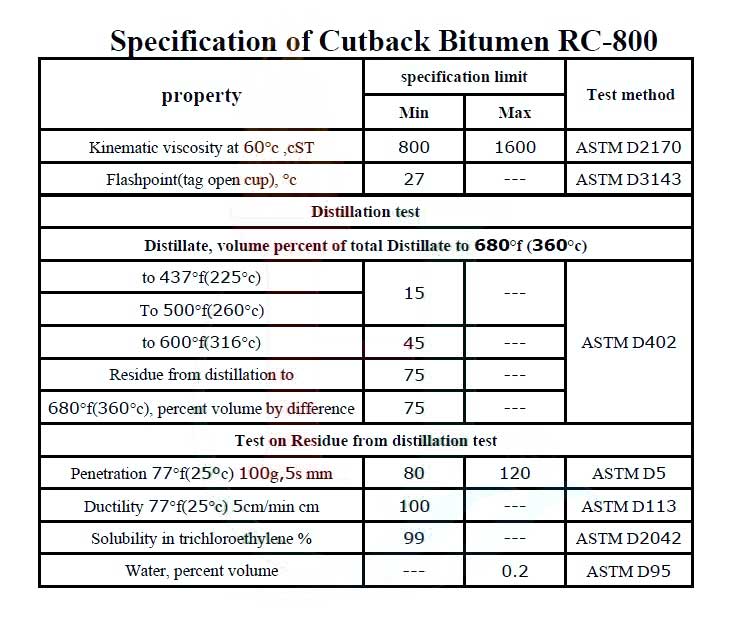Cutback Bitumen /Rapid Curing (RC)
Current common uses are in penetrating prime coats and in producing patching or stockpile mixtures.
Rapid Curing Cutback Bitumen is made by reducing the viscosity of and ordinary bitumen by adding mostly petroleum type solvent. Cutback Bitumen are used because their viscosity is lower than neat asphalt and can thus be used in low temperature applications. After a RC cutback is applied the solvent evaporates away and only the Bitumen is left. A RC cutback bitumen is said to cure as the petroleum solvent evaporates.
Rapid curing (RC) is a combination of light diluents of high volatility, generally in the gasoline or naphtha boiling point range (RC -30, RC-70, RC-250, RC-800, RC-3000), and asphalt cement.
Applications Of Rapid Curing Cutback Bitumen
RC Cutback bitumen are typically used as prime coats and tack coats. Generally Cutback Bitumen are divided into three groups depending on their volatility of the solvent added. The rapid-setting grades are designed to react quickly primarily for spray applications, such as bond / tack coats, aggregate chips seals, sand seals and similar surface treatments.
Safety Of Rapid Curing Cutback Bitumen
1.Refer to Safety Data sheets before use
2.Transport, use and store at the lowest temperature possible
3.Eliminate all potential ignition sources during application
4.Avoid breathing vapors. Avoid contact with skin
5.Always wear appropriate PPE including heat protection when used hot
6.DO NOT allow product or washings to enter stormwater or sewer systems
Packing Of Rapid Curing Cutback Bitumen
- Bulk as IBC Tank, Flexi Tank
- Reconditioned steel drums 220 lit., Net Weight: 191 ± 3 Kg
- New steel drums 220 lit., Net Weight: 191 ± 3 Kg
Rapid Curing Cutback Bitumen Types
Cutback Bitumen RC-30
Cutback bitumen RC-30 is an asphalt cement that has a solvent or distillate such as gasoline, diesel fuel, kerosene, or naphtha added to make the asphalt liquid at ambient temperatures and improve its ability to coat aggregates. Two letters followed by a numerical digit designate or name a cutback asphalt.
Cutback asphalt can contain between 12 and 40 percent distillate. The high demand for the distillates to be used in energy applications and ever-increasing air quality regulations have caused a steady decline in the use of cutback asphalt.
When gasoline or naphtha is used to flux asphalt cement, the final product is called “rapid curing” (RC) cutback asphalt. Specifications permit up to 45 percent distillate in manufacturing an RC-30 cutback asphalt.
Cutback Bitumen RC-30 complies with cutback petroleum asphalts of the rapid-curing type for use in the construction and treatment of pavements as per ASTM D2028-97 reapproved in 2004. Cutback Grade Bitumen is normally used in spraying and in some mixing applications. Cutback Bitumen is penetration grade bitumen blended with a solvent such as kerosene, white spirit, gasoline, and naphtha, controlling the curing time. Cut back petroleum asphalts of the rapid curing type supplied by Laira Group . are petroleum grade bitumen manufactured from the fractional / vacuum distillation of crude oil blended with a solvent. Bitumen supplied by Laira Group . is produced from the vacuum residue (short residue) feedstock. Penetration Grade bitumens are specified by the penetration and softening point test. Designation is by penetration range only. The penetration grade bitumens have a thermoplastic property which causes the material to soften at high temperatures and to harden at lower temperatures. This unique temperature/ viscosity relationship is important when determining the performance parameters such as the adhesion, rheology, durability, and application temperatures of bitumen. The cutback bitumen (Asphalts) supplied by Huei Jie are blended from petroleum grade bitumen as stated herein.
Application of Cutback bitumen RC-30
Current common uses are in penetrating prime coats and in producing patching or stockpile mixtures. Cutback asphalt used in mixing with aggregate will usually contain an adhesion agent to assist in the coating of the aggregate surface.
Guaranty and Safety of Cutback bitumen RC-30
Laira Group guaranty quality of cutback Bitumen RC-30 with the arrangement of the international inspector. By checking the quality and quantity of the bitumen on each shipment during the loading to the vessel. Also controlling the production by QC team via batch test report before shipping.
Packing of Cutback bitumen RC-30
Packing of cutback bitumen RC-30 is in new thick steel drum on the pallet to prevent any leak inside of the container, IBC Tank, and also bulk in bitutainer.
Cutback Bitumen RC-70
Cutback Bitumen RC-70 is Rapid curing (RC) cut-back asphalt consisting of penetration grade asphalt cement and diluent or cutter of rapid volatility. It that contains 55% bitumen, is black in color, and is manufactured strictly as per ASTM D-2028M standard.
Cutback Bitumen RC-70 is dissolved of bitumen in solvents of gasoline. In many countries, kerosene and other volatile petroleum-derived products are added as a cutter or cutback agent to bitumen to reduce (or cutback) the viscosity of the bitumen. The mixture obtained may be called cutback bitumen.

The penetration grade bitumens have a thermoplastic property which causes the material to soften at high temperatures and to harden at lower temperatures. This unique temperature/ viscosity relationship is important when determining the performance parameters such as the adhesion, rheology, durability, and application temperatures of bitumen.
The reduction in viscosity of the bitumen aids the construction of seal coats in road pavements as the softened mixture wets the chips more easily. The cutback agent evaporates from the seal coat, the cutback agent becoming a negligible component of the seal coat a few months after application. If significant amounts of the cutback agent remain in the seal coat an unwanted long term softening effect may result.
Application of Cutback Bitumen RC-70
Current common uses are in penetrating prime coats and in producing patching or stockpile mixtures. Cutback asphalt used in mixing with aggregate will usually contain an adhesion agent to assist in the coating of the aggregate surface.
Packing of Cutback Bitumen RC-70
Packing of cutback bitumen RC-70 is in new thick steel drum on the pallet to prevent any leak inside of the container, IBC Tank, and also bulk in bitutainer.
Guaranty and Safety of Cutback Bitumen RC-70
Laira Group guaranty quality of cutback Bitumen RC-70 with the arrangement of the international inspector. By checking the quality and quantity of the bitumen on each shipment during the loading to the vessel. Also controlling the production by QC team via batch test report before shipping.
Cutback Bitumen RC-250
Cutback Bitumen RC-250 is Rapid curing (RC) cut-back asphalt consisting of penetration grade asphalt cement and diluent or cutter of rapid volatility. Our Cutback Bitumen RC-250 complies with cutback petroleum asphalts of the rapid-curing type for use in the construction and treatment of pavements.
Cutback Bitumen RC-250 is a rapid curing cutback bitumen that contains 65% bitumen, is black in color, and is manufactured strictly as per ASTM D 2028M standard. The diluent temporarily reduces the viscosity of the asphalt cement for ease of handling and application. After application, the diluent evaporates, leaving asphalt cement to perform its function. RC–250 bitumen viscosity is between 250-500 CST.

Cutback Bitumen RC-250 is dissolved of bitumen in solvents of gasoline. In many countries, kerosene and other volatile petroleum-derived products are added as a cutter or cutback agent to bitumen to reduce (or cutback) the viscosity of the bitumen. The mixture obtained may be called cutback bitumen.
The reduction in viscosity of the bitumen aids the construction of seal coats in road pavements as the softened mixture wets the chips more easily. The cutback agent evaporates from the seal coat, the cutback agent becoming a negligible component of the seal coat a few months after application. If significant amounts of the cutback agent remain in the seal coat an unwanted long term softening effect may result.
Applications Of Cutback Bitumen RC-250
Current common uses are in penetrating prime coats and in producing patching or stockpile mixtures. Cutback asphalt used in mixing with aggregate will usually contain an adhesion agent to assist in the coating of the aggregate surface.
Packing Of Cutback Bitumen RC-250
This cutback bitumen bulk in the tanker and also in new steel and thick drum on the pallet to prevent all leak inside of the container.
Safety Of Cutback Bitumen RC-250
1.Refer to Safety Data sheets before use.
2.Transport, use and store at the lowest temperature possible.
3.Eliminate all potential ignition sources during application.
4.Avoid breathing vapors. Avoid contact with skin.
5.Always wear appropriate PPE including heat protection when used hot.
6.DO NOT allow product or washings to enter stormwater or sewer systems.
Cutback Bitumen RC-800
Cutback Bitumen RC-800 is an asphalt cement that has a solvent or distillate such as gasoline, diesel fuel, kerosene, or naphtha added to make the asphalt liquid at ambient temperatures and improve its ability to coat aggregates. Two letters followed by a numerical digit designate or name a cutback asphalt.
Cutback asphalt can contain between 12 and 40 percent distillate. The high demand for the distillates to be used in energy applications and ever-increasing air quality regulations have caused a steady decline in the use of cutback asphalt. When gasoline or naphtha is used to flux asphalt cement, the final product is called “rapid curing” (RC) cutback asphalt. Specifications permit up to 45 percent distillate in manufacturing an RC-800 cutback asphalt.
Cutback Bitumen RC-800 complies with cutback petroleum asphalts of the rapid-curing type for use in the construction and treatment of pavements as per ASTM D2028-97 reapproved in 2004. Cutback Grade Bitumen is normally used in spraying and in some mixing applications. Cutback Bitumen is penetration grade bitumen blended with a solvent such as kerosene, white spirit, gasoline, and naphtha, controlling the curing time. Cut back petroleum asphalts of the rapid curing type supplied by Laira Group are petroleum grade bitumen manufactured from the fractional / vacuum distillation of crude oil blended with a solvent.
Penetration Grade bitumens are specified by the penetration and softening point test. Designation is by penetration range only. The penetration grade bitumens have a thermoplastic property which causes the material to soften at high temperatures and to harden at lower temperatures. This unique temperature / viscosity relationship is important when determining the performance parameters such as the adhesion, rheology, durability, and application temperatures of bitumen.
Applications Of Cutback Bitumen RC-800
Current common uses are in penetrating prime coats and in producing patching or stockpile mixtures. Cutback asphalt used in mixing with aggregate will usually contain an adhesion agent to assist in the coating of the aggregate surface.
Cutback agents are used to lower the viscosity of bitumen when it is applied as a primer to the surface of a road pavement aggregate base course or substrate. Kerosene is used as a bitumen cutback agent at different concentrations according to local conditions and requirements.
The cutback bitumen is ideal for prime coat and cold applied because of easy uses and no need to thinning and heating. Cutback bitumen RC-800 consist of initial incorporation of asphalt into the surface of non-asphalt based course preparatory to any superimposed treatment of construction. The cutback bitumen RC-800 applying to waterproofing of surfaces, plug capillary voids, coat and bond loose mineral particles .
Packing Of Cutback Bitumen RC-800
This cutback bitumen bulk in the tanker and also in new steel and thick drum on the pallet to prevent all leak inside of the container.
Safety Of Cutback Bitumen RC-800
1.Refer to Safety Data sheets before use.
2.Transport, use and store at the lowest temperature possible.
3.Eliminate all potential ignition sources during application.
4.Avoid breathing vapors. Avoid contact with skin.
5.Always wear appropriate PPE including heat protection when used hot.
6.DO NOT allow product or washings to enter stormwater or sewer systems.
Cutback Bitumen RC-3000
Cutback asphalt is an asphalt cement that has a solvent or distillate such as gasoline, diesel fuel, kerosene, or naphtha added to make the asphalt liquid at ambient temperatures and improve its ability to coat aggregates. Two letters followed by a numerical digit designate or name a cutback asphalt.
Cutback asphalt can contain between 12 and 40 percent distillate. The high demand for the distillates to be used in energy applications and ever-increasing air quality regulations have caused a steady decline in the use of cutback asphalt.
When gasoline or naphtha is used to flux asphalt cement, the final product is called “rapid curing” (RC) cutback asphalt. Specifications permit up to 45 percent distillate in manufacturing an RC-3000 cutback asphalt.
Our Cutback Bitumen RC-3000 complies with cutback petroleum asphalts of the rapid-curing type for use in the construction and treatment of pavements as per ASTM D2028-97 reapproved in 2004. Cutback Grade Bitumen is normally used in spraying and in some mixing applications.
Cutback Bitumen is penetration grade bitumen blended with a solvent such as kerosene, white spirit, gasoline, and naphtha, controlling the curing time. Cut back petroleum asphalts of the rapid curing type supplied by Laira Group are petroleum grade bitumen manufactured from the fractional / vacuum distillation of crude oil blended with a solvent.
Penetration Grade bitumens are specified by the penetration and softening point test. The designation is by penetration range only. The penetration grade bitumens have a thermoplastic property which causes the material to soften at high temperatures and to harden at lower temperatures. This unique temperature/ viscosity relationship is important when determining the performance parameters such as the adhesion, rheology, durability, and application temperatures of bitumen.
Applications Of Cutback Bitumen RC-3000
Current common uses are in penetrating prime coats and in producing patching or stockpile mixtures. Cutback asphalt used in mixing with aggregate will usually contain an adhesion agent to assist in the coating of the aggregate surface.
Cutback agents are used to lowering the viscosity of bitumen when it is applied as a primer to the surface of a road pavement aggregate base course or substrate. Kerosene is used as a bitumen cutback agent at different concentrations according to local conditions and requirements. The cutback bitumen is ideal for prime coat and cold applied because of easy uses and no need to thinning and heating.
Cutback bitumen RC-3000 consist of initial incorporation of asphalt into the surface of non-asphalt based course preparatory to any superimposed treatment of construction. The cutback asphalt RC-3000 applying to waterproofing of surfaces, plug capillary voids, coat and bond loose mineral particles.
Packing Of Cutback Bitumen RC-3000
Packing of cutback bitumen RC-3000 is in the new thick steel drum on the pallet to prevent any leak inside of container also bulk in bitutainer and tanker.
Safety of cutback bitumen RC-3000
1.Refer to Safety Data sheets before use.
2.Transport, use and store at the lowest temperature possible.
3.Eliminate all potential ignition sources during application.
4.Avoid breathing vapors. Avoid contact with skin.
5.Always wear appropriate PPE including heat protection when used hot.
6.DO NOT allow product or washings to enter stormwater or sewer systems.







